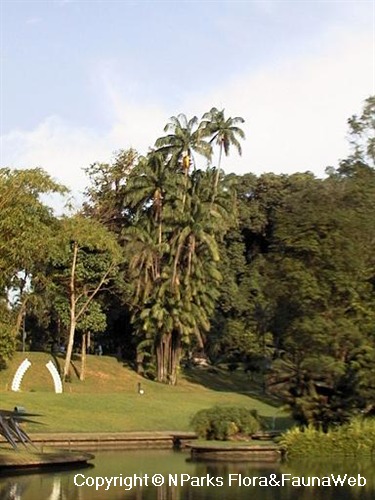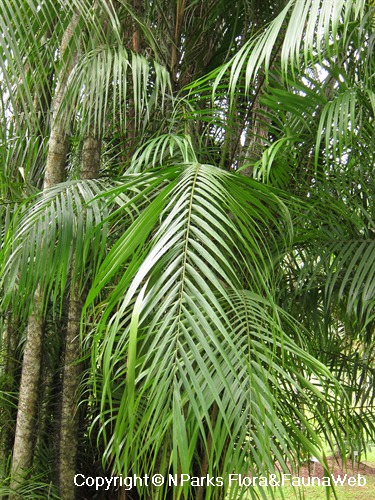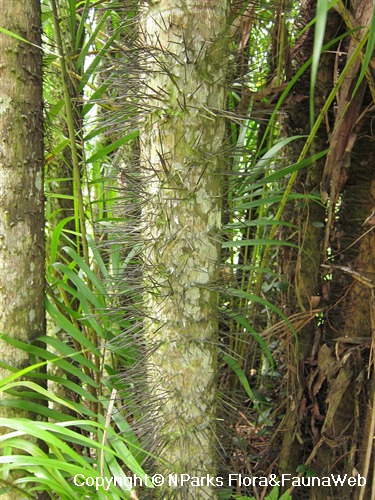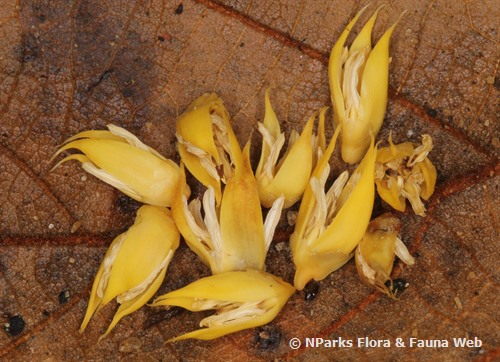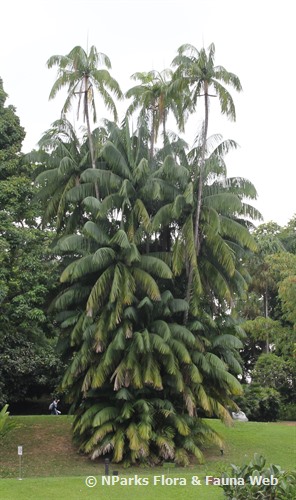
Back
Oncosperma tigillarium (Jack) Ridl.
| Family Name: | Arecaceae (Palmae) |
| Common Name: | Nibung, Nibong, Nibung Palm |
Name
Classifications and Characteristics
| Plant Division | Angiosperms (Flowering Seed Plants) (Monocotyledon) |
|---|---|
| Plant Growth Form | Palm (Clustered Habit) |
| Mode of Nutrition | Autotrophic |
| Maximum Height | 30 m |
Biogeography
| Native Distribution | Southeast Asia |
|---|---|
| Native Habitat | Terrestrial |
| Preferred Climate Zone | Tropical |
| Local Conservation Status | Native to Singapore (Least Concern (LC)) |
Description and Ethnobotany
| Growth Form | An immensely fabulous-looking, tall, large, slender, cespitose (tuft-forming) palm massed with armed trunks and beautiful, elegantly-arched, drooping, leathery fronds, which is sparsely distributed along the inland fringes of mangrove forest and other low, wet, swampy vegetation. |
|---|---|
| Trunk | Trunk slender, up to 15 cm in diamater, ringed with old leaf scars, numerous (up to 50), densely armed with scattered, slender black spines that are about 5 to 10 cm long; crownshaft conspicuous, armed with slender, black spines. |
| Foliage | Fronds pinnate (feather-shaped), ascending to spreading, pendulous, elegantly-arched, armed, dark to bright green. |
| Others - Plant Morphology | Flower: Inflorescences ramified (multi-branched), yellow, up to 80 cm long, infrafoliar (emerging from below the fronds), armed; flowers arranged in groups of 3 (2 male flowers to 1 female flower). Fruit: Fruits globose, 1 cm in diamater, mildly-depressed, purple to black single-seeded. |
| Cultivation | It thrives in the hot, suntrap, humid conditions of the tropical lowlands but is able to to withstand partially subtropical locations. Because it originates from growing in swampy areas, regular watering is required to keep the continuous presence of water in the soil. Propagate by seeds and suckers. Fresh seeds lose their viability quickly after collection. Seeds germinate within 3 to 6 months. |
| Etymology | Its genus epithet comes from the Greek 'oncos', 'humped' or 'swollen', and 'sperma', 'seed', in reference to the broad raphe on the seed. Its species epithet means 'with small stems', which is in reference to its thin trunks. |
| Ethnobotanical Uses | Others: Its extremely hard, rot resistant wood is used in fish traps in Borneo. |
Landscaping Features
| Landscape Uses | Coastal, Beachfront / Shoreline |
|---|---|
| Usage Hazard - Cons | Spines/Thorns - Trunk |
Plant Care and Propagation
| Light Preference | Full Sun |
|---|---|
| Water Preference | Moderate Water |
| Plant Growth Rate | Moderate |
| Rootzone Tolerance | Waterlogged Soils |
Foliar
| Mature Foliage Colour(s) | Green |
|---|---|
| Leaf Area Index (LAI) for Green Plot Ratio | 4.0 (Palm - Cluster) |
Non - Foliar and Storage
| Trunk Type (Palm) | Clustering Habit, Aboveground |
|---|
Floral (Angiosperm)
| Flower Colour(s) | Yellow / Golden |
|---|
Fruit, Seed and Spore
| Mature Fruit Colour(s) | Black, Purple |
|---|
Image Repository
Others
| Master ID | 1366 |
|---|---|
| Species ID | 2659 |
| Flora Disclaimer | The information in this website has been compiled from reliable sources, such as reference works on medicinal plants. It is not a substitute for medical advice or treatment and NParks does not purport to provide any medical advice. Readers should always consult his/her physician before using or consuming a plant for medicinal purposes. |

